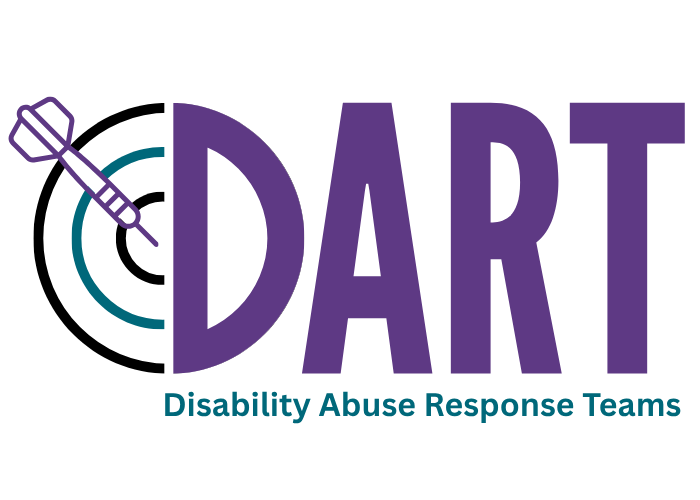DART: Disability Abuse Response Teams
What is DART?
Disability Abuse Response Teams or DARTs are local multidisciplinary teams working together to ensure that survivors with disabilities have full access to survivor services. DARTs primarily include DV/SA agencies and Disability service agencies as well as local Tribal entities, Mental Health providers, Independent Living specialists, Law Enforcement, Housing specialists, etc. Local DARTs meet regularly to share resources and expertise, problem-solve, and build partnerships. As a result, they expand their capacity to respond to the needs of individual survivors and to address the prevalence of abuse against people with disabilities overall.
Comments from DART program participants
"It made our agencies think about topics that are not regularly addressed and got
our wheels turning regarding accessibility. It also brought our partner agencies closer
together."
"Participation in DART has strengthened our ability to provide more informed and responsive
services across agencies, ensuring that victims with disabilities are not overlooked
and receive the appropriate accommodations and supports they need."
"DART has helped break down silos and build relationships that ensure victims with disabilities receive timely, compassionate, and effective support."
If you are interested in starting a DART in your community, contact DART Coordinator Kelly Hartlieb at knhartlieb01@alaska.edu. Applications are distributed in the fall of each fiscal year.
DART Project Goals
1. Recognize barriers and gaps in services faced by survivors with disabilities and work to eliminate them.
2. Provide culturally competent, trauma informed, accessible services for survivors with disabilities.
3. Create information and resource-sharing networks within communities and across the state.
DART Project Activities
DV/SA agencies and Disability agencies apply to lead DARTs in their communities each fall. Lead agencies recruit local partners and complete eight deliverables designed to raise awareness and increase accessible and inclusive survivor services. In return, lead agencies receive a stipend of $5,000.
FY26 DART Deliverables:
1. Submit Contract and Invoice Documents
2. Convene 3 Local DART Meetings
3. Technical Assistance Calls
4. Agency Accessibility Self-Assessment
5. Community Presentation
6. Advertise or Develop your Agency’s Accessibility Features
7. Monthly Webinar Series
8. Complete Project Evaluation
DART Monthly Webinar Series
Second Tuesday of the month from Noon to 1:30 p.m. (through June 2026) via Zoom
Advocates, para-professionals, providers, and community members who support abuse survivors and/or people with disabilities are welcome to participate in the DART monthly webinar series. Sessions feature presentations on topics designed to increase knowledge and skills around DV/SA and disability, prevention and response.
Participants are not required to be formally active DART members. All are welcome to join the discussion and help increase accessibility and equity for survivors with disabilities.
Register for the DART Monthly Webinar Series
(After registering, you will receive a confirmation email containing information about joining the meeting.)
Disability and Abuse
People with disabilities experience interpersonal violence and sexual abuse at rates far higher than non-disabled persons. Yet, disabled survivors face many barriers regarding reporting, accessible services, justice, and healing. The "Understanding the Problem" links show part of the problem that survivors with disablities face. The "Confronting the Problem" link is a helpful resource for providers and others working with survivors with disabilities. For additional resources, please contact the DART coordinator.
Confronting the Problem
- End Abuse Against People with Disabilities
Understanding the Problem
- Sexual Assault and Survivors with Intellectual Disabilities
- Domestic Violence and Traumatic Brain Injury
FY26 Active DART Communities/Lead Agencies
- Anchorage: Standing Together Against Rape (STAR)
Contact: Brooks Banker ‣ Phone: (907) 276-7279
- Bethel: Tundra Women’s Coalition (TWC)
Contact: Eileen Arnold, ED ‣ Phone: (907) 543-3444
Contact: Nicole Songer, ED ‣ Phone: (907) 424-5674
- Kenai/Soldotna: LeeShore Center
Contact: Ashley Blatchford ‣ Phone: (907) 283-9479
- Prince of Wales: Helping Ourselves Prevent Emergencies (HOPE)
Contact: Tiffany Mills, ED ‣ Phone: (907) 826-2581
Contact: Joel Hanson ‣ Phone: 1 (888) 487-1032
Contact: Rowena Palomar, ED ‣ Phone: (907) 835-2980











